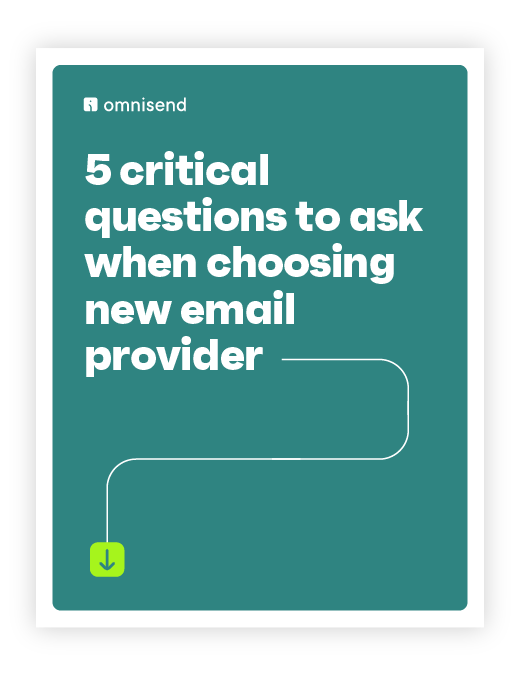
Drive sales on autopilot with ecommerce-focused features
See FeaturesTorn between Omnisend vs. Mailchimp for your email marketing? Here’s the truth — if you sell products online, Omnisend wins with purpose-built ecommerce features, omnichannel automation, and plans that include everything you need upfront.
Mailchimp is best if you’re a service business needing basic email campaigns without complex automation. Its general-purpose design works well for newsletters but requires upgrades for advanced ecommerce functionality.
Of course, there are nuances to consider, such as send limits, pricing as you scale, integrations with existing tools, and onboarding (if you need it).
Read on to discover which platform matches your business goals, budget, and growth plans — we’ll break down every feature that matters for your success.
Quick sign up | No credit card required
Omnisend vs. Mailchimp: A quick comparison
Omnisend and Mailchimp both do email marketing. Both also handle SMS marketing, although only Omnisend supports push notifications.
So, Omnisend handles more channels by default. Additionally, it lets you create separate campaigns for each channel, and add SMS and push notifications to email flows, such as abandoned cart sequences — all within a single workflow.
With Mailchimp, you’ll need to upgrade to more expensive plans for SMS capabilities. The Essentials + SMS plan starts at $33/month (compared to $13 for email-only).
Here’s a comparison table covering crucial Omnisend vs. Mailchimp features and pricing:
| Plan & Feature | Mailchimp | Omnisend |
|---|---|---|
| Free plan contacts | 500 | 250 |
| Free plan email sends | 1,000/month (500/day cap) | 500/month |
| Automation workflows | ❌ Not on free; multi-step requires Standard plan | ✅ All plans |
| A/B testing | ❌ Not on free; available on Essentials and up | ✅ All plans |
| Push notifications | ❌ Not offered natively; requires 3rd-party integration | ✅ All plans |
| SMS included | ✅ Paid SMS add-on only | ✅ Paid plans (Pro includes credits equal to plan cost) |
| Standard tier price (500 contacts) | $20/month (6,000 emails) | $16/month (6,000 emails) |
| Pro / Premium tier price (starting) | $350/month (starts at 10,000 contacts) | $59/month (unlimited emails) |
| Cost at 2,500 contacts (Standard Plan) | $60/month (30,000 email cap) | $59/month (Pro plan, unlimited sends) |
| Billable Contacts | All contacts, including unsubscribed | Subscribed contacts only |
Target audience: Who are these platforms for?
Let’s examine the specific audiences that the two leading email marketing platforms target:
General audience: Mailchimp
Mailchimp suits you if you’re a blogger, nonprofit, or service business sending basic newsletters. But if you run an online store, you’ll quickly hit limitations — without a paid plan, you get no automation workflows at all.
Even on paid plans, advanced ecommerce features like dynamic product recommendations and unified email-SMS workflows require workarounds or higher tiers.
Ecommerce focus: Omnisend
Omnisend is best if your ecommerce store needs email, SMS, and push notifications working together — it delivers all three channels in unified flows where your abandoned cart recovery can start with an email, escalate to text after four hours, then send a push notification.
Pull products directly from your store, track revenue per message, and see which items customers browsed to personalize follow-ups. Built-in discount codes and purchase-based segmentation make selling easier.
Reports focus on what matters. Which campaigns drove sales, what revenue each automation generates, and whether email or SMS converts better. Not just open rates, but financial impact.
Additional reading:
9 Mailchimp alternatives that actually deliver (2025)
1. Omnisend vs. Mailchimp: Email marketing features
Both platforms come packed with features designed to help you create, send, and track email campaigns.
But depending on your goals and how hands-on you want to be, one might be a better fit than the other.
Let’s take a look at the email marketing features of Mailchimp and Omnisend:
Ease of use
Here’s the thing: no one wants to waste time figuring out clunky software when trying to send a simple campaign. Luckily, both Mailchimp and Omnisend have done a solid job in creating a user-friendly interface that streamlines email marketing.
Omnisend’s interface is particularly intuitive to navigate, with all the key features accessible from the main navigation menu bars.
When you log into Omnisend, you’re greeted with a clean, modern dashboard. The layout is thoughtfully designed, with all the tools you need clearly labeled and quick to find. With Omnisend, you won’t have to worry about feeling overwhelmed when opening up a new marketing tool.
Mailchimp features also make a good first impression. It prioritizes ease of use in its interface design. With the features strategically placed, creating emails and checking reports feels logical and accessible.
If you’re creating email campaigns, managing subscriber lists, or analyzing campaign performance, Mailchimp’s interface provides a smooth and intuitive experience.
Whichever platform you choose, you won’t be left figuring things out on your own. Both Mailchimp and Omnisend offer a wealth of tutorials and resources on how to use the platform. So even if you’re new to email marketing, you’ll find plenty of support.
Drag-and-drop email builder
Both platforms include a drag-and-drop email builder, which makes designing campaigns much less intimidating if you don’t have a background in design. But when it comes to flexibility and features, which one pulls ahead?
If you’re running an ecommerce store, here’s why using Omnisend will put you ahead of the game:
- Drag-and-drop content blocks specifically designed for ecommerce: Product carousels, personalized product recommendations, discount codes, plus you can move elements freely and customize the content within each block
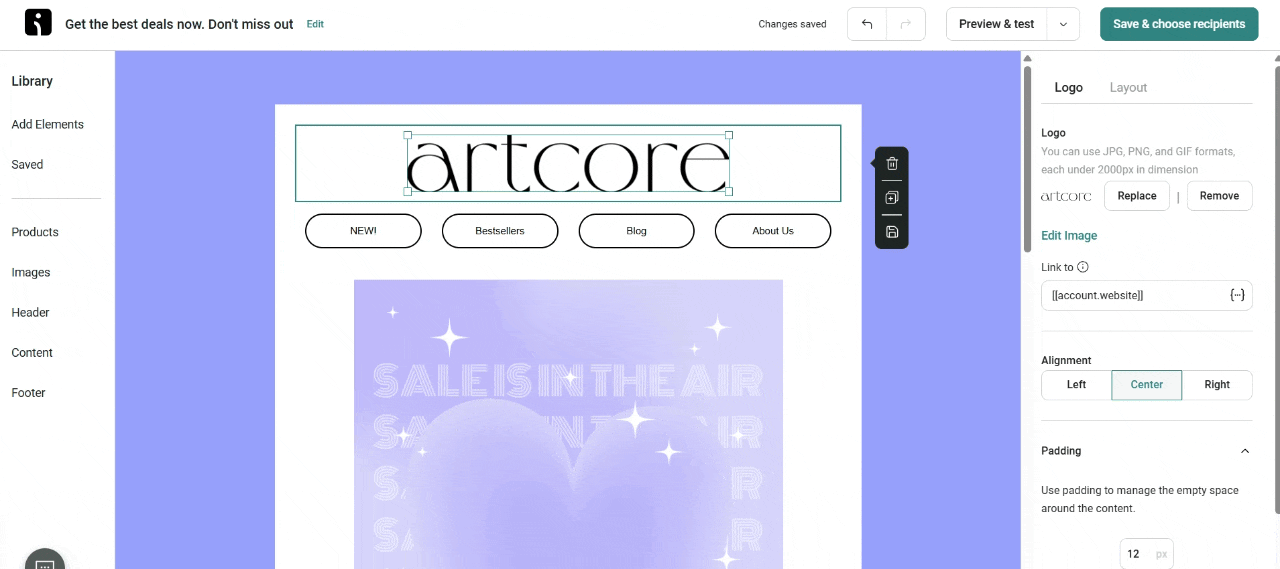
- No coding needed, but it’s there if you want it: You can quickly customize layouts with content blocks, with no coding knowledge, or get hands-on with HTML and CSS if you want more control
- Automatically imports your store’s branding: Your logo, brand colors, fonts, and social media links are automatically applied in many template library options
- Mobile-friendly by default: Omnisend’s builder includes automatic mobile stacking, which means your two- or three-column layouts reformat perfectly on smaller screens, no manual adjusting required
And here’s a bonus: Every Omnisend user gets full access to the drag-and-drop builder’s features, including free plan members. You can start with pre-built templates or create emails from scratch using various content elements.
Good to know
Omnisend now extends personalized product recommendations to Campaign emails for Pro plan merchants. Previously exclusive to automations, you can now include dynamic recently viewed products in your campaigns, helping your customers see relevant items based on their browsing history.
This video provides more insight into Omnisend’s email builder:
Mailchimp’s builder offers similar drag-and-drop functionality and can get the job done. But if we’re comparing it to Omnisend, especially from an ecommerce angle, it’s limited. It has fewer ecommerce templates, and while you can customize emails and rearrange elements, the customization options aren’t as extensive as Omnisend’s.
- Building emails is great for beginners: Building an email in Mailchimp can be done from scratch, with a basic layout, or with a fully pre-designed template, so it’s not overwhelming for a beginner:
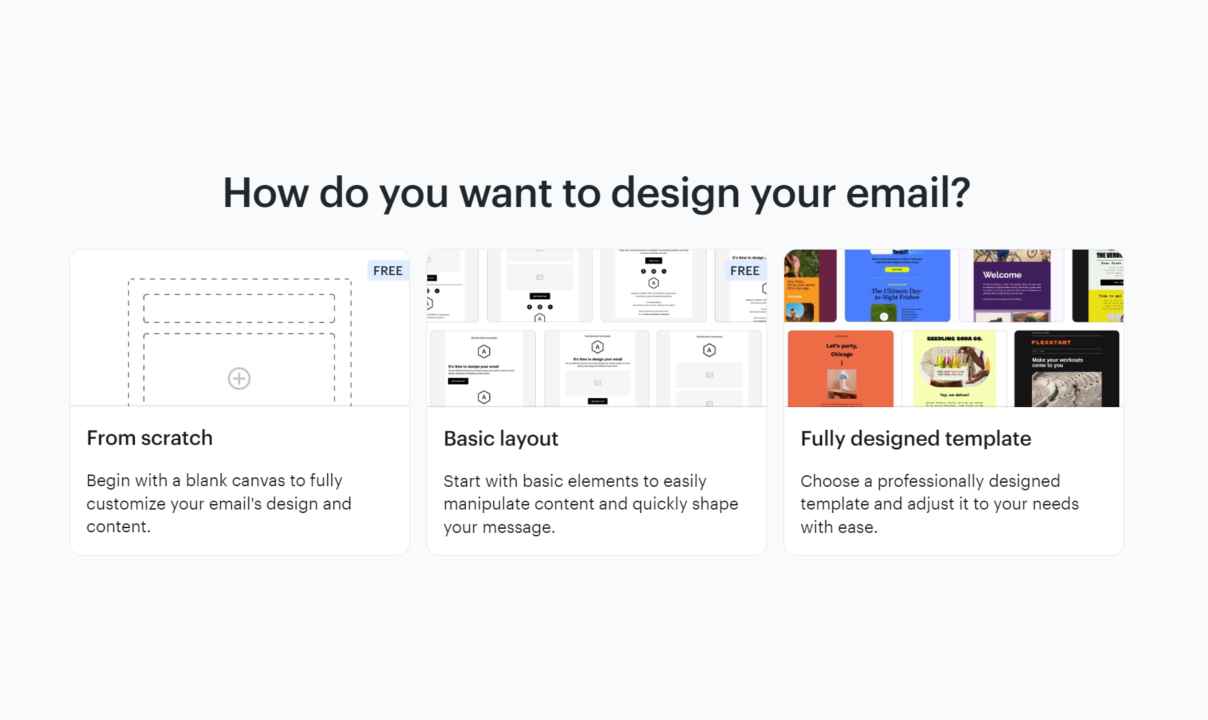
- Good basics on the free plan: Even without upgrading, you can use Mailchimp’s basic layouts, which still look professional, although other design features and more templates are restricted to paid plans
Here’s how Mailchimp’s email builder looks:
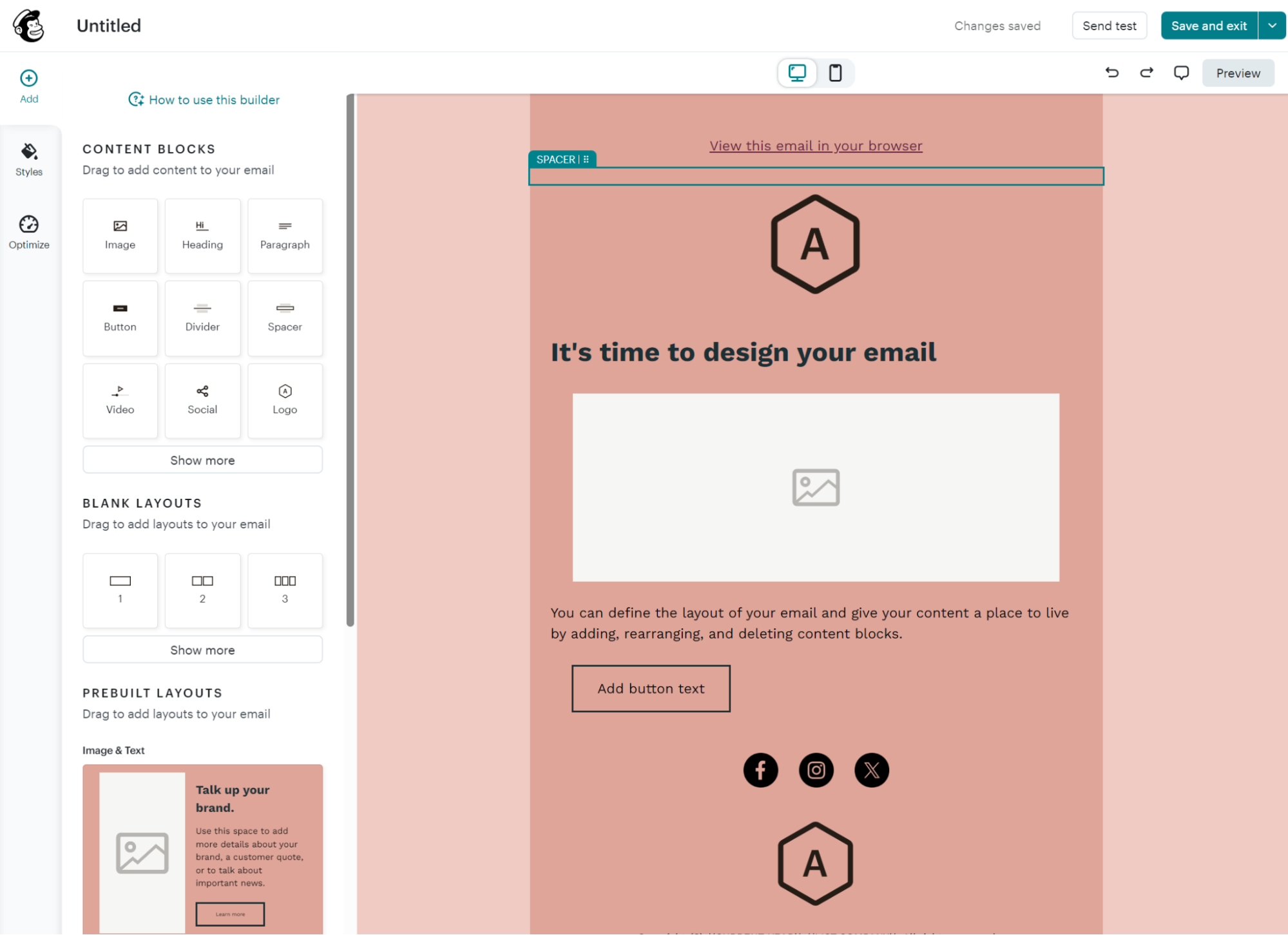
- Want full design power? You’ll need a paid plan: If you want fully designed templates with a real-time preview functionality, you’ll need to upgrade your plan
- Style your emails for different devices: You can add content blocks, device-specific styling options, and pre-built layouts, plus unlink desktop and mobile styles to customize content separately for each device
If you’re a small business just starting out, Mailchimp’s free plan is functional enough. But if you’re an ecommerce user, you might feel too restricted.
Email templates
Both Mailchimp and Omnisend include high-quality email templates, but the limited options provided by Mailchimp may not suit all stages of your customer journey.

Mailchimp’s templates look professional, but there’s a catch: fully designed email templates are restricted to paid plans. Meanwhile, Omnisend provides 250+ ready-made email templates to everyone, paid plan or not.
Plus, Omnisend’s native integration allows you to pull products directly from your online store, offer smart product recommendations, and automatically include discount codes within emails.
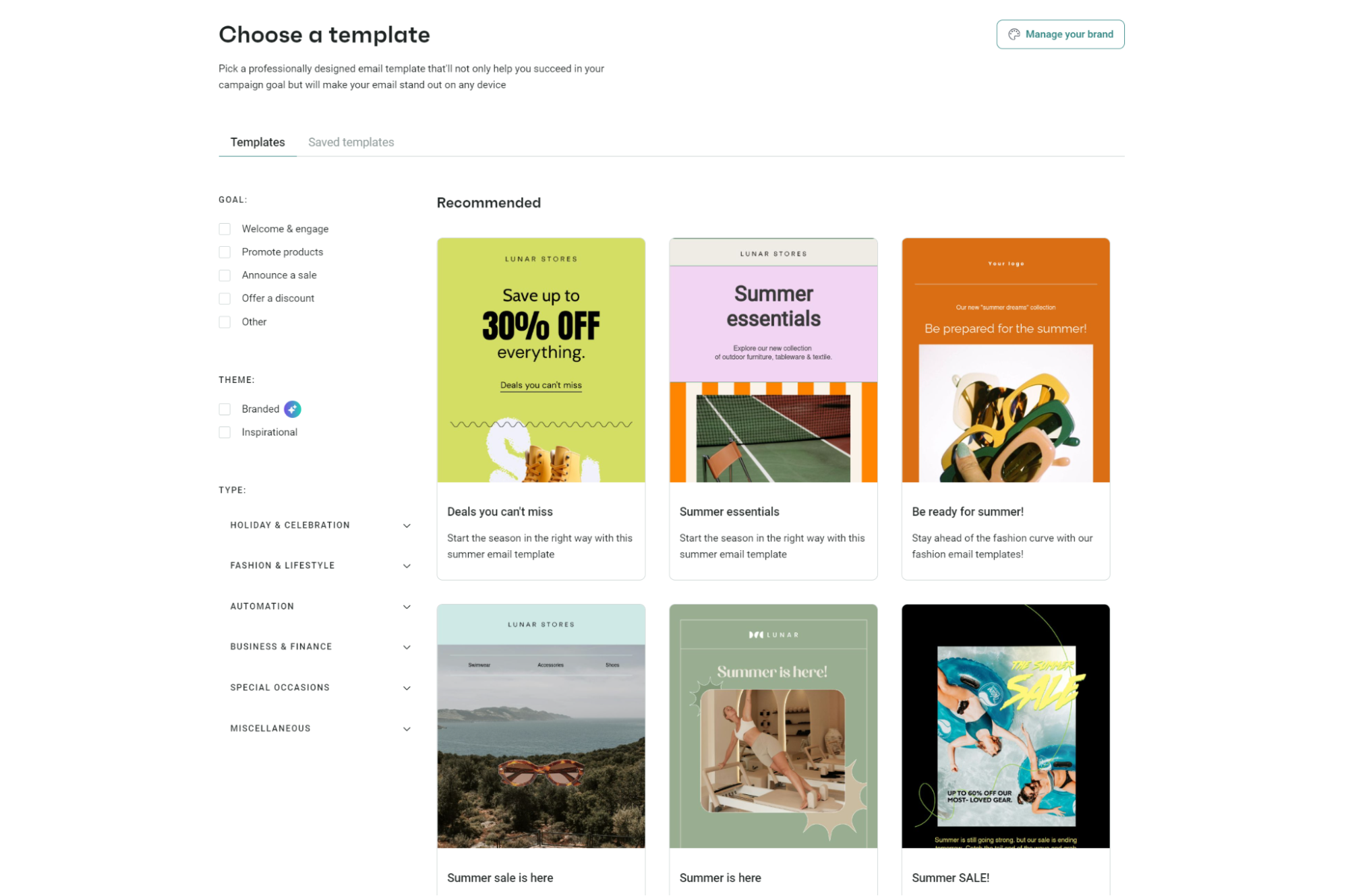
While both platforms allow you to create your templates, only Omnisend allows you to save individual blocks that you can easily reuse in future campaigns.
Landing page builder
Capturing leads is step one in growing your email list, and both Mailchimp and Omnisend make that stress-free with dedicated landing page builders and signup forms. But depending on your campaign goals and how much flexibility you want, one platform gives you more control.
Mailchimp offers a library of pre-designed landing page templates, covering everything from product promotions to free content downloads and newsletter signups.
If you’re using an ecommerce platform like Shopify or WooCommerce, Mailchimp’s landing page builder allows you to pull product images directly into your landing pages. This is a big plus for showcasing featured items or collections.
Here’s a screenshot of Mailchimp’s stock landing page templates in its free plan:
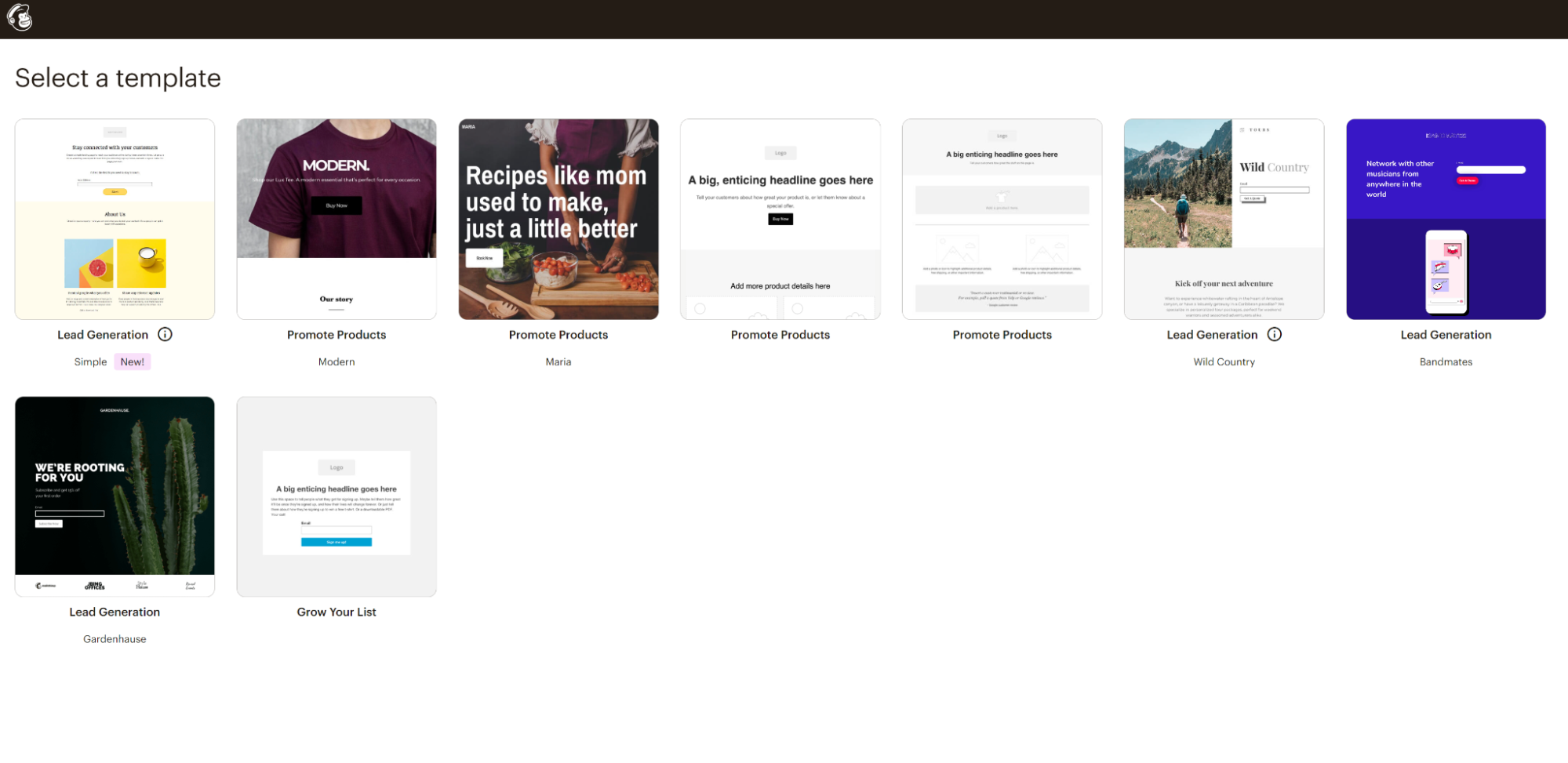
Omnisend goes a step further when it comes to customization and campaign control. You can create dedicated landing pages for lead generation and special campaigns, like product launches, pre-sales, contests, and subscriber preference collection.
Another handy feature is the ability to turn any popup into a landing page — in a single click, you can repurpose content you’ve already created.
The biggest pro is that you control everything — form width up to 1000px, background images, form placement, and social sharing previews. What’s more, you can schedule pages to go live automatically for time-sensitive campaigns, set expiration dates, and redirect subscribers to your store after signup.
Check out Omnisend’s landing page templates below, including options for multi-step email and SMS capture:
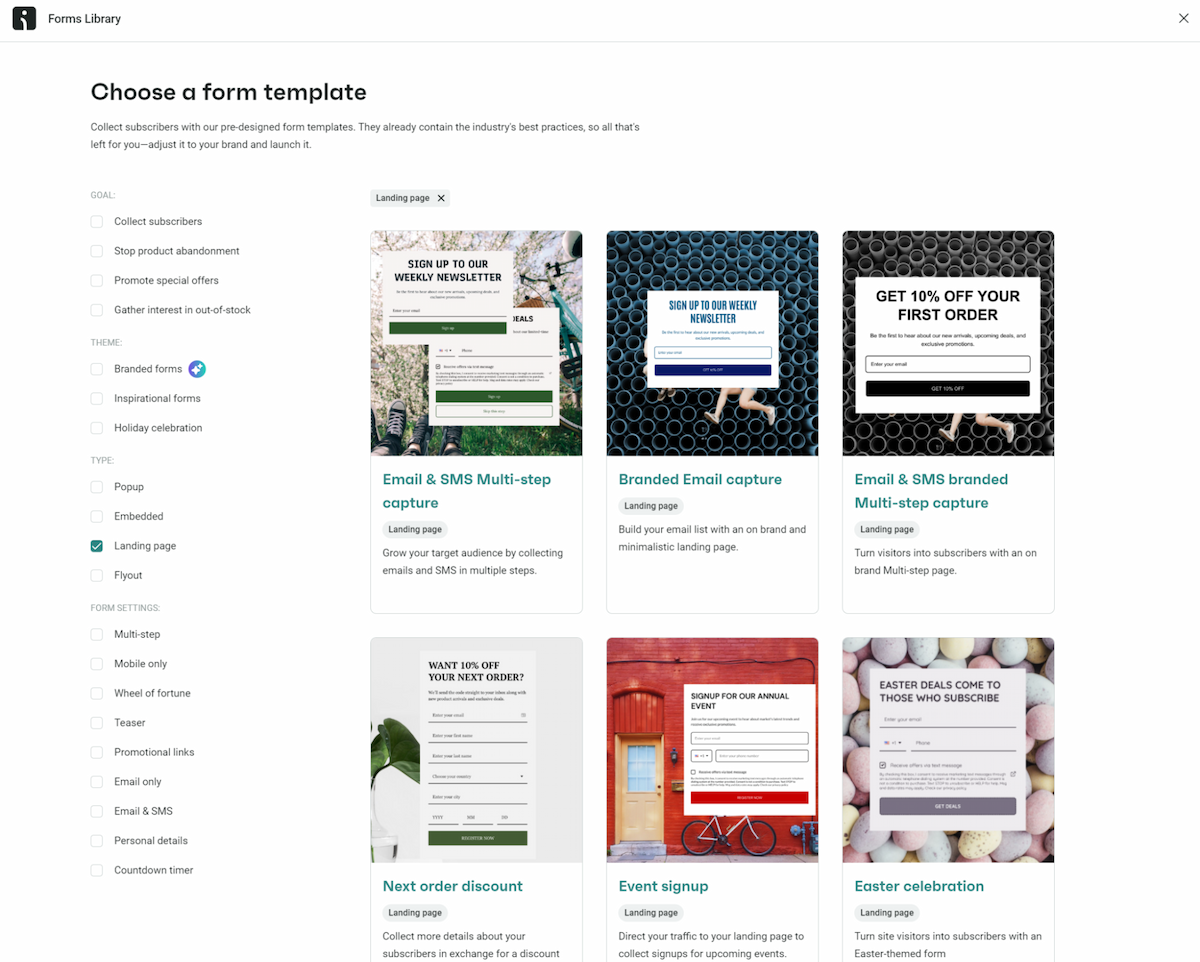
Quick sign up | No credit card required
Popup forms
Both platforms offer popups, embedded forms, and inline email signup forms — but take different approaches to signup collection.
Omnisend treats popups as a testing ground — think of it like running mini conversion experiments across your site. For instance, you could run a Wheel of Fortune game for first-time visitors while showing a discount box to cart abandoners, and target high-value customers with offers based on browsing patterns.
Also, Omnisend offers 90+ professionally designed, pre-built popup form templates — the screenshot below shows only a fraction of what’s on offer:
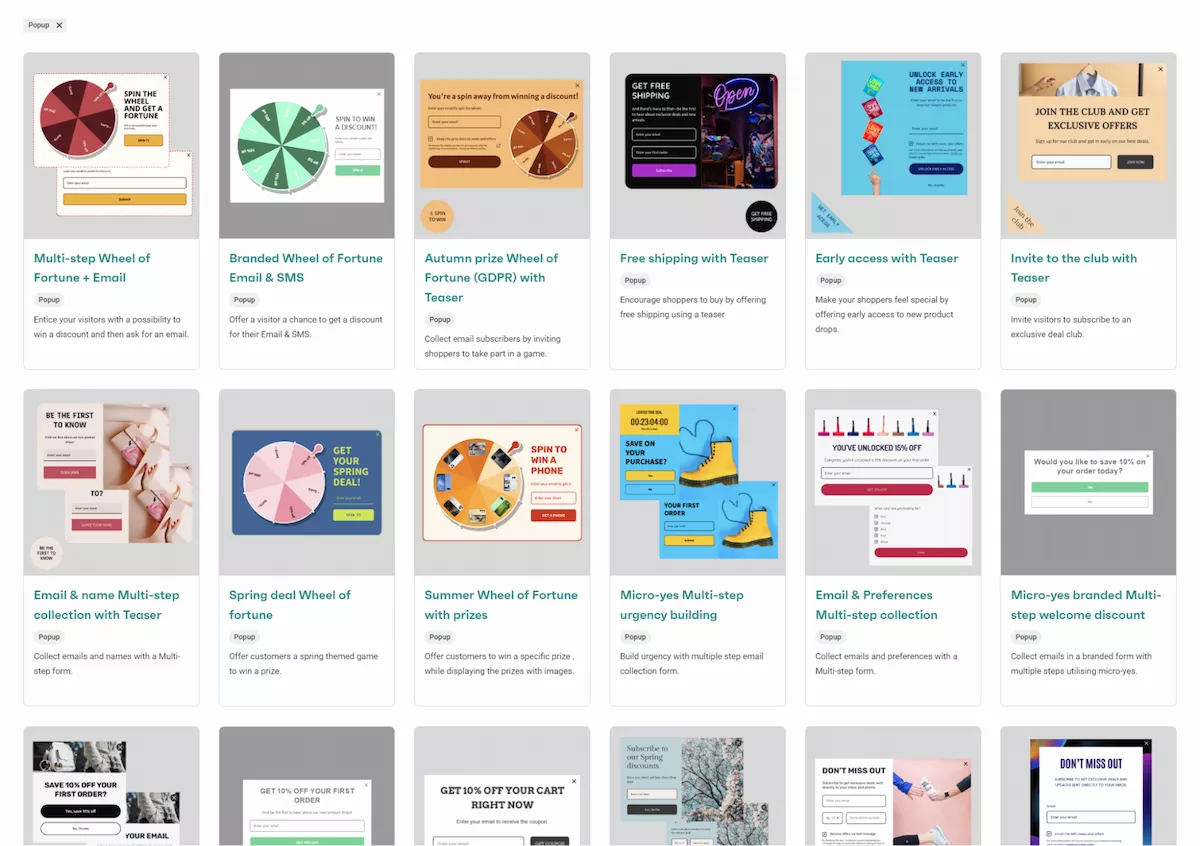
A/B testing works across multiple active forms. Test different headlines on your footer signup while experimenting with timing triggers on your main popup — without pausing either campaign. Reports show which combinations of design, timing, and targeting drive signups.
It includes multi-step forms that break signup into digestible chunks. Instead of asking for everything up front, collect an email first, then request preferences or phone numbers on the next screen.
Mailchimp’s capabilities are more template-centric, giving you over 100 pre-built popup templates organized by purpose. Want to promote a seasonal sale? Try “Holiday Border Cardstyle.” Need something sporty? “Athletic Wavy” is a perfect fit.
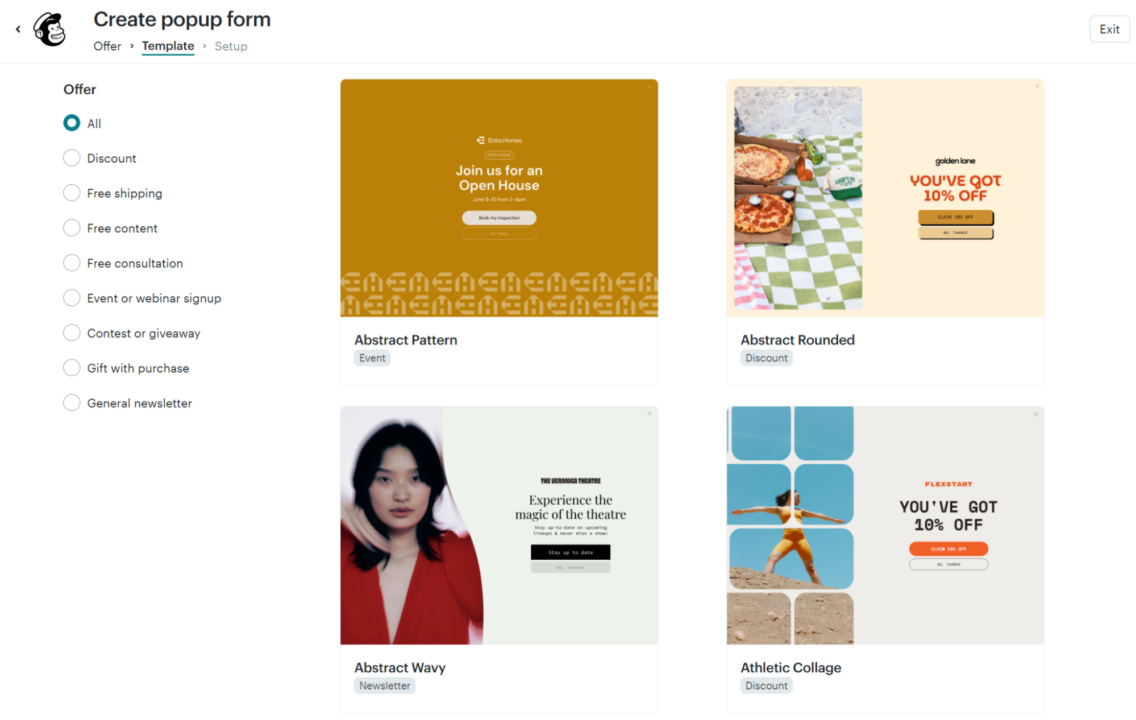
While both platforms offer popup functionality, Omnisend emphasizes behavioral targeting and simultaneous testing capabilities. Its approach lets you adapt popup strategies to different visitor segments without compromising your overall collection efforts.
Watch this video to learn more about Mailchimp’s and Omnisend’s popups:
A/B testing
Omnisend lets you test various email components, including subject lines, sender names, offers, discounts, images, and text content.
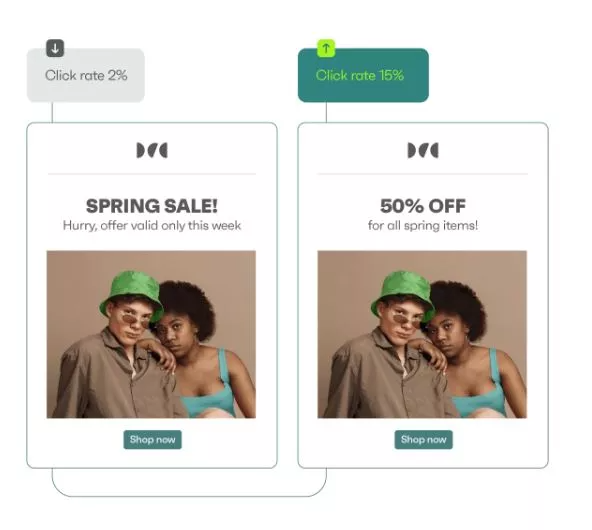
Here’s the part marketers love: You get to choose your success metric based on what matters most for your campaign. Want more opens? Track it with Omnisend. Focused on clicks on sales? You can decide.
Plus, Omnisend also allows you to set the duration for your A/B test, so you gather enough data to make a statistically sound decision — and not just a lucky guess.
Mailchimp also lets you test subject lines, content, sender names, and send times. It takes things up a notch with multivariate testing — available only on the premium plan. This allows you to test combinations of multiple elements simultaneously.
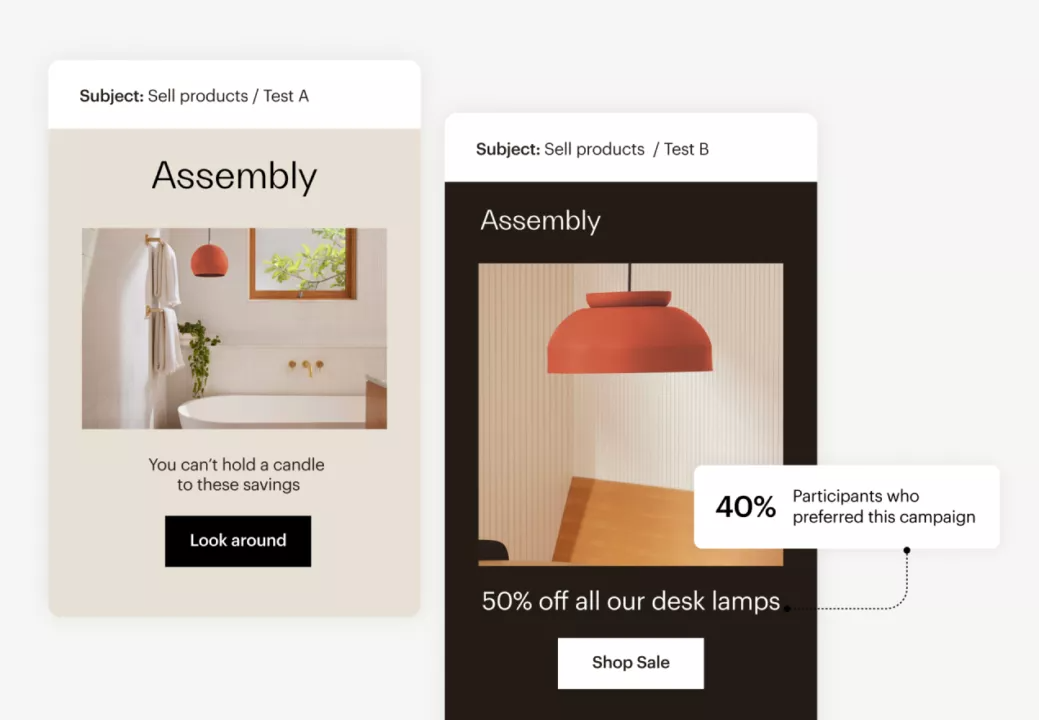
You get flexibility when choosing your success metric, too. You can pick clicks, opens, or even revenue generated as the deciding factor for your winning campaign.
Reporting and analytics
If you’re putting effort into your campaigns, you want to know what’s working — and more importantly, why. Looking at Mailchimp vs. Omnisend, both offer reporting tools, but Omnisend goes much deeper when it comes to ecommerce-specific insights.
Here’s what you get with Omnisend:
- Product-level revenue tracking: See which items each campaign or automation sold. Every message shows total revenue, orders placed, and conversion rates, not just opens and clicks.
Here’s an image of a report:
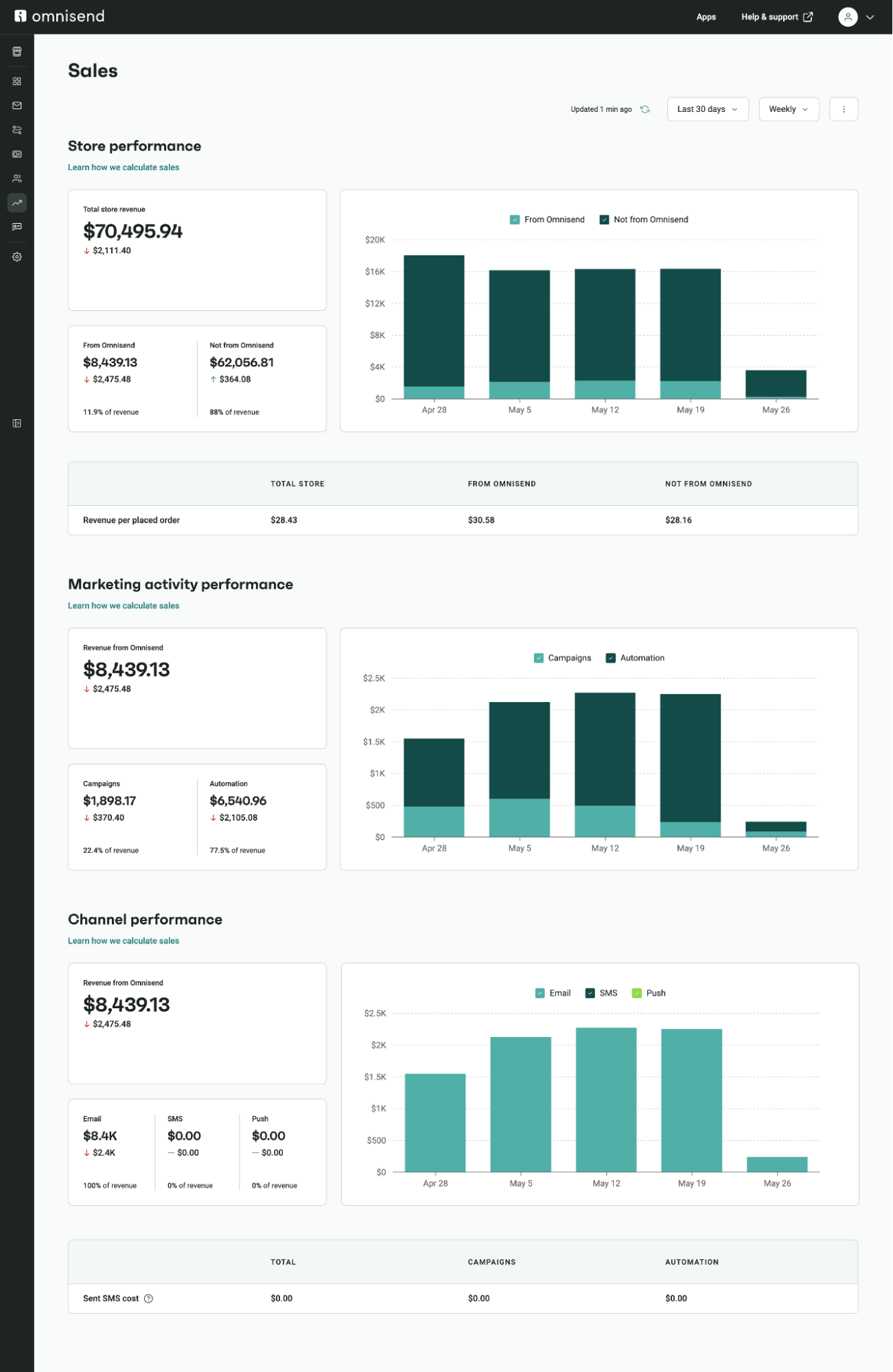
- Detailed automation analytics: Automation analytics reveal performance across each workflow step. Track where customers drop off in your cart recovery sequence, which SMS versus email performs better, and how much revenue each touchpoint generates.
- Multi-channel campaign breakdowns: The Campaigns tab breaks down metrics by channel, showing email versus SMS effectiveness side-by-side. Sort campaigns by revenue to spot your biggest winners, or filter by date ranges to analyze seasonal trends.
- Industry benchmarks: Omnisend shows inline benchmarks. So, you’ll know if your 22% open rate beats or lags behind similar stores.
- Historical data goes back indefinitely: Compare this year’s Black Friday to the last five years. You can also track how customer behavior shifted over time.
This video demonstrates Omnisend’s reporting features in more detail:
Mailchimp offers the standard email metrics:
- Opens, clicks, bounces, and unsubscribes
- Revenue tracking when connected to your store
- Creates charts for engagement and sales data, though limited to one-year views with its Metrics Visualizer (on Standard plans and up)
Mailchimp also includes an AI Content Optimizer, which scores your subject lines against successful campaigns, but it lacks the granular ecommerce insights — like product performance tracking or multi-step automation analytics — that drive merchandising and marketing decisions.
Mailchimp vs. Omnisend round one winner: Omnisend
2. Omnisend vs. Mailchimp: Pricing comparison
Both platforms offer free plans for new ecommerce stores and scale appropriately. But, the way they structure those plans — and what you actually get at each level — is very different. Where Omnisend provides access to all standard features on all plans, Mailchimp restricts features with larger send limits.
Free plans
Omnisend Free plan
- 250 contacts
- 500 emails/month
- Automation workflows
- Popup forms
- SMS capabilities and push notifications
- All standard features
Mailchimp Free plan
- 500 contacts
- 1,000 emails/month
That higher send limit comes at the cost of no automation workflows, email scheduling, A/B testing, or dynamic content (such as product recommendations).
Paid plan pricing
Omnisend is cheaper than Mailchimp, starting at $16/month for 500 contacts and 6,000 emails, one time gift of $1 in SMS credits, and unlimited push. The Pro plan at $59/month adds unlimited emails, advanced reporting, and bonus SMS credits equal to the price of your monthly plan.
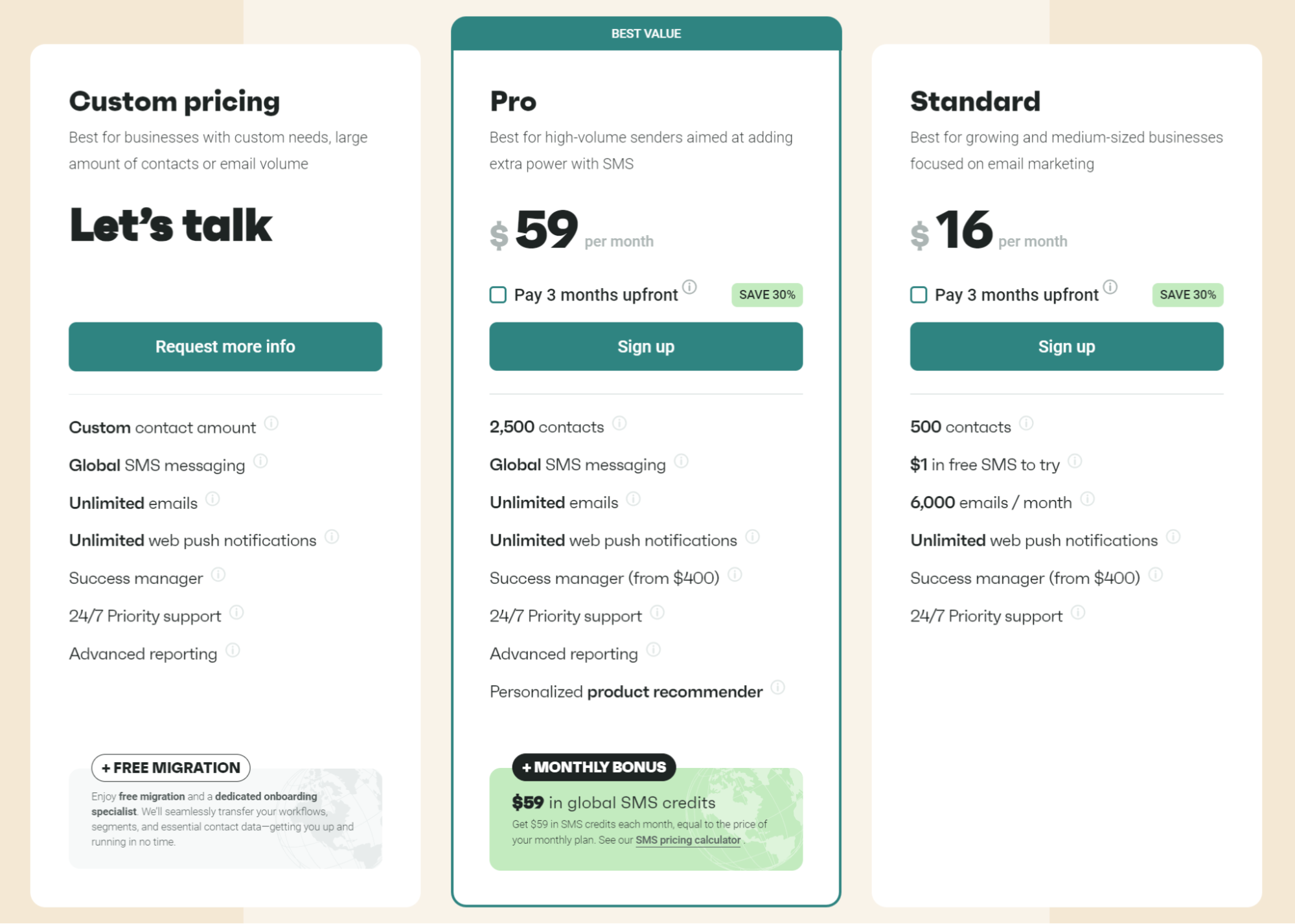
Mailchimp’s Essentials plan costs $13/month for 5,000 emails but caps automations at four steps. Standard runs $20/month with full automation access, and Premium requires a 10,000 contact minimum at $350/month.
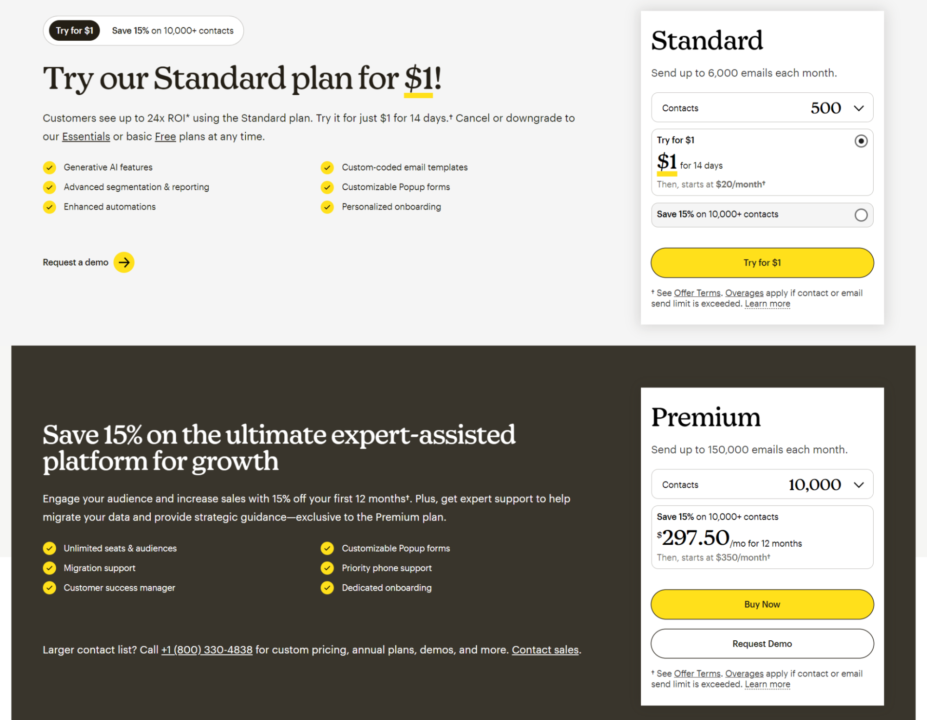
If you want to integrate SMS into your email, automations, and social campaigns, Mailchimp provides Essentials + SMS, Standard + SMS, and Premium + SMS plans:
- Essentials + SMS: $33/month
- Standard + SMS: $40/month
- Premium + SMS: $317.50/month
How costs scale
Contact growth impacts pricing differently on each platform. Omnisend Pro stays at $59/month for 2,500 contacts with unlimited sends. Mailchimp Standard reaches $75/month at that level with a 30,000 email cap. On all plans, the Mailchimp pricing chart is higher.
Channel differences
Push notifications come as standard with every Omnisend plan — Mailchimp doesn’t offer push at all. Both platforms support SMS on paid plans, though Omnisend Pro sweetens the deal with monthly SMS credits matching your subscription cost.
Mailchimp vs. Omnisend round two winner: Omnisend
For more information, use our email pricing calculator below to quickly compare costs and features with Mailchimp. Input your desired number of contacts, select Mailchimp from the list, and see how Omnisend stacks up against it.
Quick email provider pricing comparison
Quickly and easily compare the top email marketing providers so you can find the best platform for your ecommerce store needs.
prices for:
You can compare Omnisend and 2 more providers at once.
- Omnisend
- Klaviyo
- Mailchimp
- Drip
- Moosend
- Active Campaign
- Get Response GetResponse
- MailerLite
You can compare Omnisend and 2 more providers at once.
Select at least one provider.
Try out the full version of this calculator
3. Omnisend vs. Mailchimp: Segmentation capabilities
Segmentation lets you group customers based on their behavior, shopping activity, preferences, and demographics, and send them relevant messages.
Omnisend’s ecommerce marketing report shows abandoned cart, welcome, and browse abandonment segments drove 87% of all automated orders, with one in two people who clicked these messages making a purchase.
Omnisend builds segments around shopping patterns. Target customers who spent over $500 last quarter, or people who browsed but didn’t buy in 30 days. Pre-built options include “likely to buy again” and “VIP customers” based on purchase history.
Here’s a screenshot of 12 pre-built automations in Omnisend:
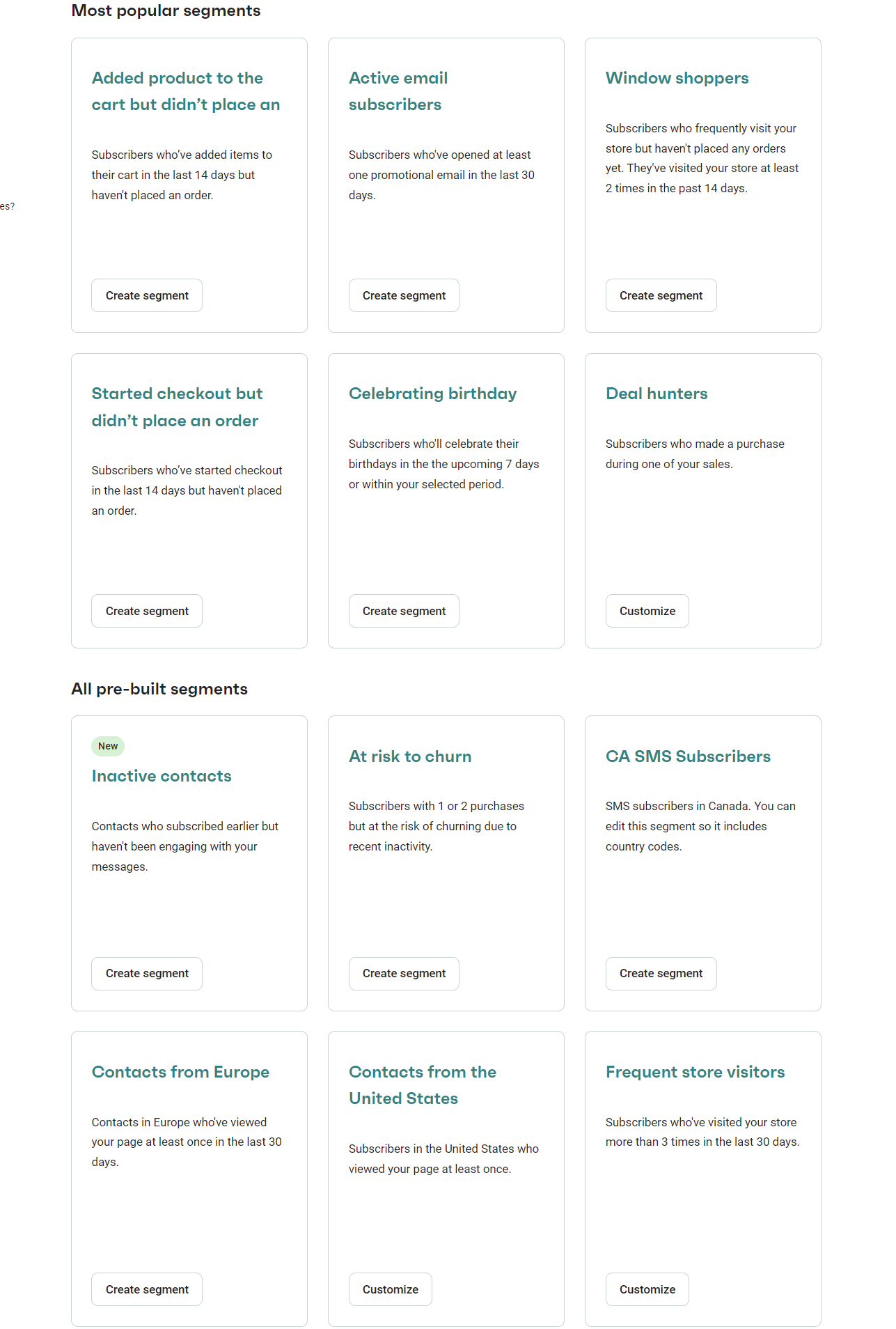
Even better, you can combine multiple filters — say, customers in New York who bought shoes and opened your last three emails. Or segment by lifecycle stage, so that first-time buyers get a welcome series, while repeat customers see loyalty rewards.
Mailchimp also offers segmentation, but with more restrictions based on your plan:
- Free plan: Basic filters like signup date and location
- Standard and Premium plans: Demographics and behavioural segmentation, plus access to predictive and advanced segmentation
It handles traditional segments well — campaign activity, email domain, and signup source. But ecommerce filters like “bought product X but not Y” or “average order value above $100” require workarounds or custom fields.
“In Mailchimp, you can’t send people down different flows based on what they just added to their cart, for example:
- You can only split based on historical data, which are conditional splits – Not what triggered the flow.
- So if someone adds Product A vs Product B to their cart, you can’t show them a tailored upsell or cross-sell sequence unless you build a workaround. That’s a massive limitation for ecommerce.
Omnisend solves that. You get:
- Trigger splits based on the exact item added
- Dynamic flows with proper if/then logic
- Segmentation by purchase behaviour, location, message engagement and more”
Gavin Hewitson
Founder of In-box | Email Marketing & SMS Marketing | Klaviyo Certified In-box.co.nz
The difference matters for revenue. Omnisend’s back-in-stock emails to interested segments achieved 59% open rates and 5% conversion rates in 2024. When segmented messages convert at 2,361% better rates than campaigns, precision targeting pays off.
Both Mailchimp and Omnisend offer segmentation based on:
- Profile data: Language, location, age, income, gender, education, occupation, etc.
- Campaign activity: Whether the person has opened your emails, clicked certain links, or shown interest in particular campaigns
- Purchases: Products they’ve viewed, purchased, or abandoned from their cart
Mailchimp vs. Omnisend round three winner: Omnisend
4. Omnisend vs. Mailchimp: Marketing automation
Both platforms include automation templates to accelerate setup. But when it comes to flexibility, multi-channel integration, and ecommerce features, Omnisend pulls ahead.
Omnisend provides 27 automation presets, including abandoned cart flows with cart value splits, browse abandonment sequences, and cross-sell campaigns with A/B delay testing.
Mailchimp’s flow builder includes templates for welcome series, purchase follow-ups, birthday campaigns, and re-engagement sequences. Each template comes with default timing and content suggestions you can customize.
Here’s a screenshot showing some of Omnisend’s pre-built automations:
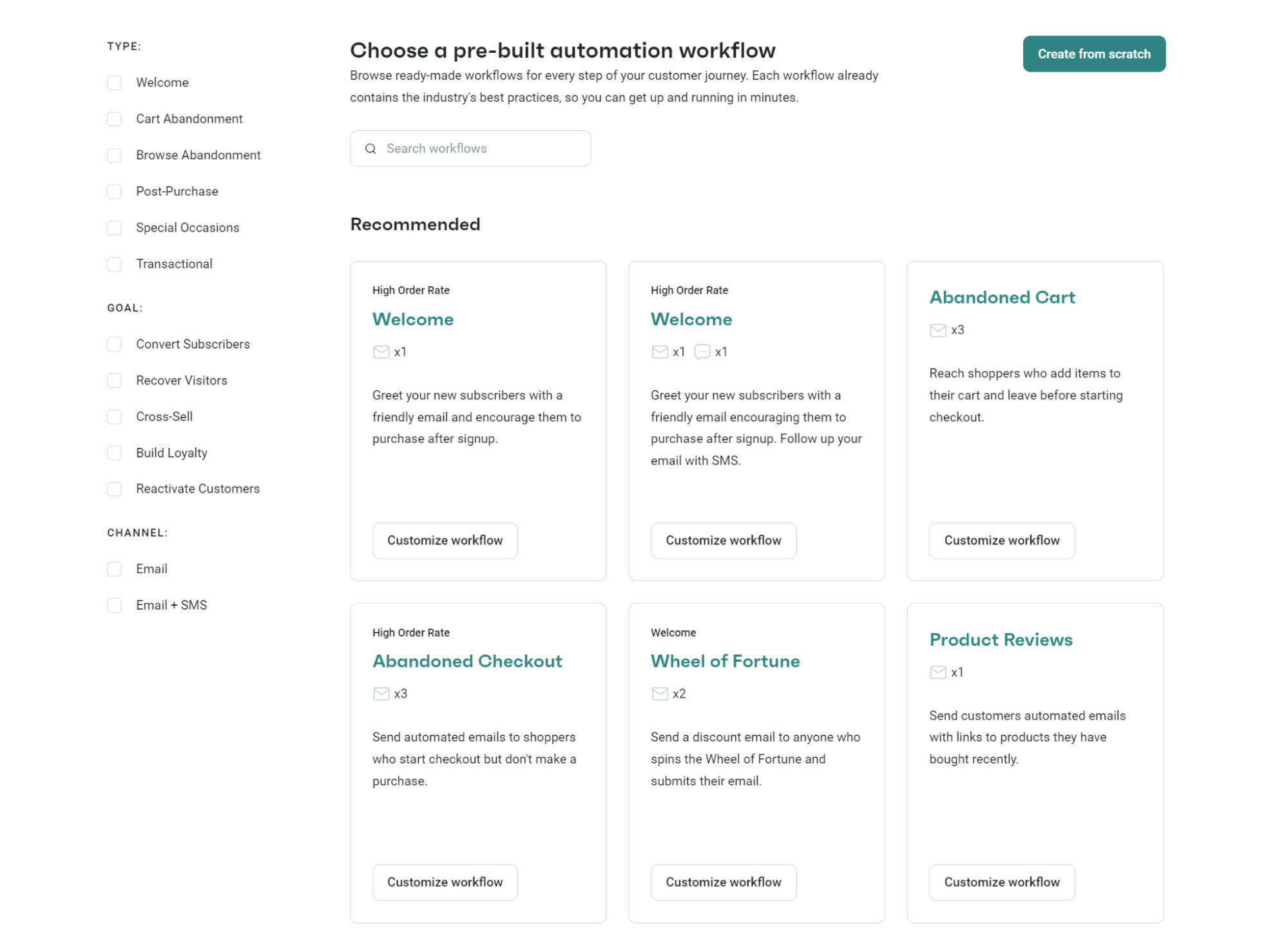
These automations cover email and email + SMS. Mailchimp also lists automations in its dashboard, but combines flows for other apps and integrations to encourage you to sync your tech stack:
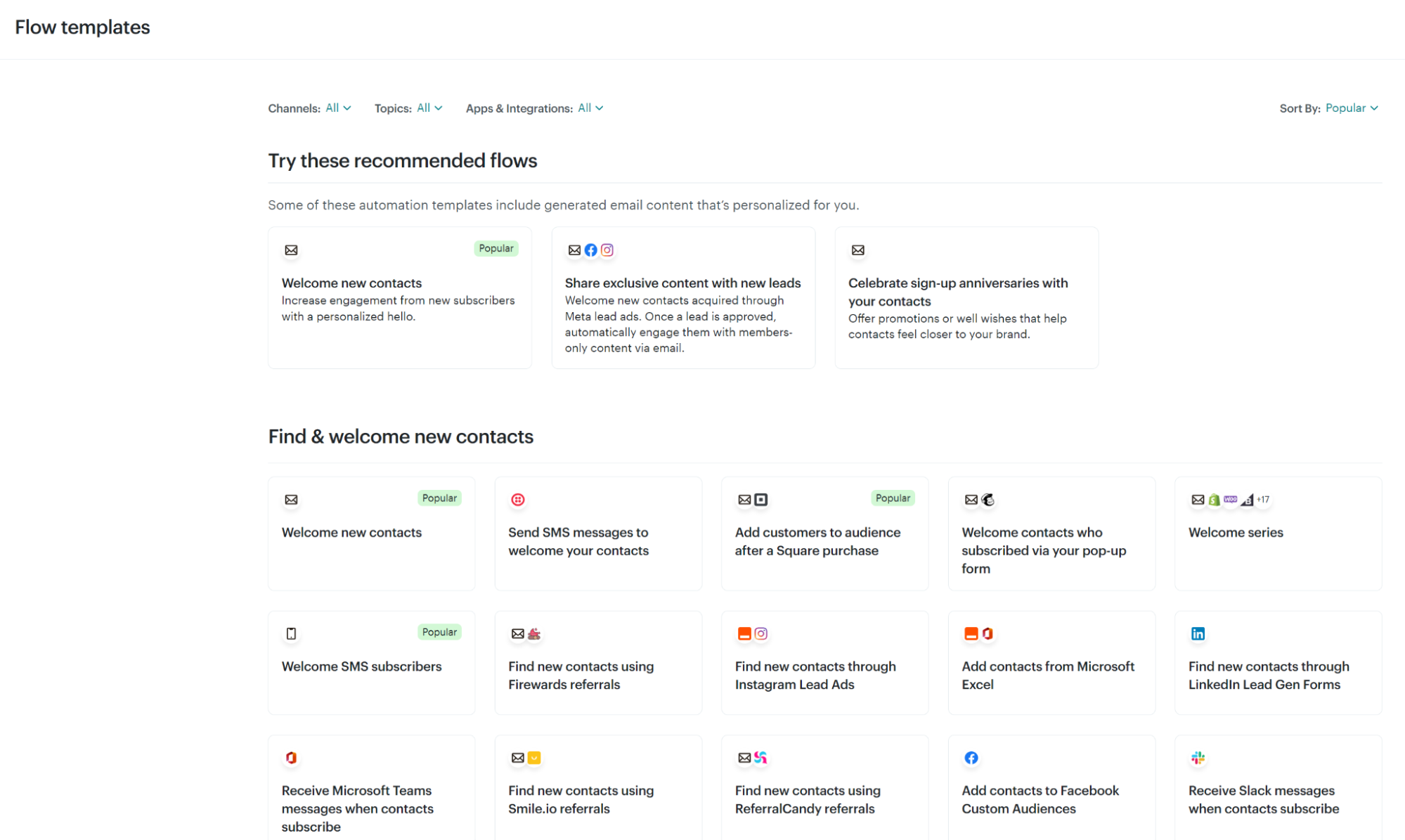
Workflow complexity
Omnisend supports 20 conditional splits per workflow with five rules each.
Build paths that react to real behavior — customers who view shoes get different messages than those browsing jackets. Split by order value to offer percentage discounts on small carts, free shipping on large ones.
Multi-channel sequences live in single workflows. Your abandoned cart automation sends an email after one hour, an SMS after four hours if unopened, then a final push notification with a discount. Everything tracks in one place.
Mailchimp caps workflows at 200 steps total. Conditional branching is available at the Standard tier, but remains email-focused. Free plans get zero automation. The Essentials plan lets you build four-step sequences, more than enough for basic welcome emails, but not much else.
Trigger variety
Omnisend’s 27 automation presets cover the money-making moments — cart abandonment (driving 87% of automated orders per 2024 data), browse abandonment, cross-sell timing, and restock alerts. Trigger on products viewed, categories browsed, or purchase patterns.
Templates include welcome series, date-based campaigns, purchase follow-ups, and re-engagement flows. It also handles standard ecommerce triggers — abandoned carts, first purchases, and customer win-backs work out of the box.
Channel integration
Omnisend treats channels as building blocks within workflows. Drag email, SMS, and push blocks wherever needed. Non-subscribers skip channels they haven’t opted into, continuing through the sequence. One workflow handles everything.
Mailchimp runs each channel separately, so, for instance, email automations can’t trigger SMS sends. Coordinating an abandoned cart campaign across email and text means building two workflows, hoping timing aligns. No push notifications exist to coordinate anyway.
What this means for your store
- Complex customer journeys need Omnisend’s branching logic and unified workflows
- Basic email sequences work fine in Mailchimp if you pay for Standard or above
- Multi-channel sellers save time with Omnisend’s integrated approach
- Both platforms handle core ecommerce automations, but execution differs significantly
Mailchimp vs. Omnisend round four winner: Omnisend
5. Omnisend vs. Mailchimp: Deliverability
Getting emails into inboxes matters more than any other marketing metric. If your messages land in spam, nothing else counts — not your design, copy, or offers. Both Omnisend and Mailchimp understand this, but take different approaches to ensuring inbox placement.
Omnisend’s deliverability tools
Omnisend provides a deliverability dashboard showing sender reputation across major ISPs. Every contact gets an automatic risk score. High-risk addresses get flagged before sending, not after damage occurs.
Here’s a screenshot of the Deliverability report in Omnisend:

The dashboard tracks email list hygiene and shows deliverability status with color-coded labels. Good, fair, or poor ratings indicate whether your sender domains and email addresses meet best practices. When metrics drop, you can clean your audience directly from the report.
Account Experts (available from $400/month) work on authentication setup, domain warming, and placement troubleshooting. ISP feedback loops show which subscribers marked emails as spam, helping you clean lists faster.
Mailchimp’s approach
Mailchimp advertises 99% delivery rates to receiving servers. It enforces strict anti-spam policies and runs Omnivore, an automated system that flags risky sending behavior.
However, deliverability tools remain basic. No dedicated dashboard exists. You check open rates and bounce rates in standard reports to infer inbox placement. Seed testing requires third-party tools. Proactive monitoring and alerts aren’t available at any tier.
Support stays reactive rather than preventive. While Mailchimp offers onboarding specialists for initial setup, ongoing deliverability guidance requires upgrading to Premium plans at $350/month minimum.
The business impact
If you send regular campaigns, Omnisend’s proactive approach prevents revenue loss from spam folder placement. Real-time monitoring, built-in testing, and expert support create confidence that your emails reach customers, not just servers.
Mailchimp vs. Omnisend round five winner: Omnisend
6. Omnisend vs. Mailchimp: AI features
If you’re drowning in daily marketing tasks, AI can be your lifeline. But Mailchimp and Omnisend take entirely different approaches to helping you work smarter.
A crucial limitation to consider before we jump into their capabilities is that Mailchimp’s generative AI features are only for Standard and Premium customers, so if you’re considering its Essentials or Free plan, you’ll need to pay more. Omnisend has no AI restrictions.
Omnisend’s AI toolkit
Brand consistency happens automatically in Omnisend. Upload your logo, colors, and fonts once. Every template pulls them in without manual setup.
Omnisend includes AI generators for subject lines, preheaders, and body copy. Feed it your campaign goal, and get multiple versions to test. The AI Writer reviews your content in real-time, flagging unclear messaging and suggesting improvements.
Campaign Booster brings back lost revenue automatically. When subscribers don’t open your first send, it follows up 48 hours later with a new subject line. You could see 15–20% higher open rates without lifting a finger.
Segmentation gets less stressful, too. Type what you want in plain English, and Omnisend’s AI Segment Builder converts it to targeting rules:

RFM analysis visualizes your entire customer base by purchase behavior, highlighting champions, at-risk buyers, and everyone in between.
Product recommendations work dynamically. Each email shows items that your customer browsed or purchased, not one-size-fits-all suggestions.
Mailchimp’s AI approach
Mailchimp’s Intuit Assist builds complete automation workflows from simple prompts. Ask for a welcome series, get five emails with subject lines, content, and timing ready to go.
Predictive tools scan purchase patterns to spot tomorrow’s VIPs and next week’s churners. Send time optimization watches when people open, then delivers your next campaign at their peak engagement hour.
Content Optimizer benchmarks your emails against successful campaigns, flagging weak spots. Creative Assistant turns brand uploads into fresh designs. The content generator produces complete email drafts — headlines, body copy, CTAs — in your brand voice.
So, which tool has better AI?
If you need help with daily marketing execution, Omnisend’s AI removes the friction. If you’re ready to optimize based on predictive data and want deeper Intuit integration, Mailchimp offers those advanced capabilities.
Mailchimp vs. Omnisend round six winner: Omnisend
7. Omnisend vs. Mailchimp: Integrations
If you want to pull a customer’s review history into their next email, trigger campaigns when orders ship, and segment VIPs by loyalty points earned, you need integrations.
Omnisend and Mailchimp both connect to over 100 apps, but each takes a different approach. One goes deep on commerce-specific connections, the other casts a wider net across business tools.
Omnisend’s integration approach
Omnisend offers 160+ integrations built for ecommerce workflows. Shopify and WooCommerce sync deeply — tracking product views, cart contents, purchase history, and customer lifetime value in real-time.
The Shopify integration enables automation triggers that Mailchimp can’t match. Set flows based on collections viewed, products abandoned, or order status changes. Customer tags sync bidirectionally, so segmentation stays consistent across platforms.
BigCommerce and Wix connections track orders and customers just as thoroughly. Loyalty programs sync point balances — LoyaltyLion knows when someone hits VIP status, Smile.io tracks referral rewards.
Review apps, such as Yotpo and Reviews.io, push ratings data into segments so that you can target happy customers differently from frustrated ones.
Shipping integrations make post-purchase emails smarter. AfterShip triggers “out for delivery” messages, while ShipStation updates feed into delivery confirmations.
Quiz builders like Typeform send results that trigger product recommendations. Even support tickets from Gorgias or Re:amaze inform your messaging — no more promotional emails to customers with open complaints.
Mailchimp’s integration ecosystem
Mailchimp’s 300+ integrations cover far more ground than just ecommerce. Yes, Shopify, WooCommerce, BigCommerce, and Wix connect for standard order and customer tracking. But the real strength lies elsewhere.
CRM systems feed deep customer histories into campaigns. Salesforce deal stages trigger different email sequences. HubSpot contact properties enable granular targeting. QuickBooks knows who paid on time versus who’s overdue — perfect for tailored follow-ups.
Social connections work both ways. Pull Instagram engagement data for segmentation, or push email content directly to Facebook.
Design assets flow from Canva templates to campaigns. Adobe Creative Cloud keeps brand assets consistent. Analytics tools measure impact beyond opens and clicks — Google Analytics tracks site behavior, Mixpanel shows product usage patterns.
Choosing based on integration needs
Your best choice depends on where your data lives — running everything on Shopify? Then Omnisend’s ecommerce integrations extract more value from that data. Managing customers across multiple systems? Mailchimp’s wider net catches more information from more places.
Mailchimp vs. Omnisend round seven winner: Mailchimp
8. Omnisend vs. Mailchimp: Omnichannel marketing
Email alone doesn’t cut it anymore. Your customers expect coordinated messaging across email, SMS, and push notifications — missing any channel means missing revenue.
The good news is that both Omnisend and Mailchimp let you target customers across email and SMS. However, only Omnisend supports push notifications.
Omnisend’s unified approach
Omnisend treats SMS and push as core channels, not afterthoughts.
Build automation workflows mixing all three channels in one sequence. For instance, you could start with an abandoned cart email, follow with an SMS four hours later, then send a push notification with a discount code if your customer still hasn’t purchased.
Here’s an automation flow example for abandoned cart:
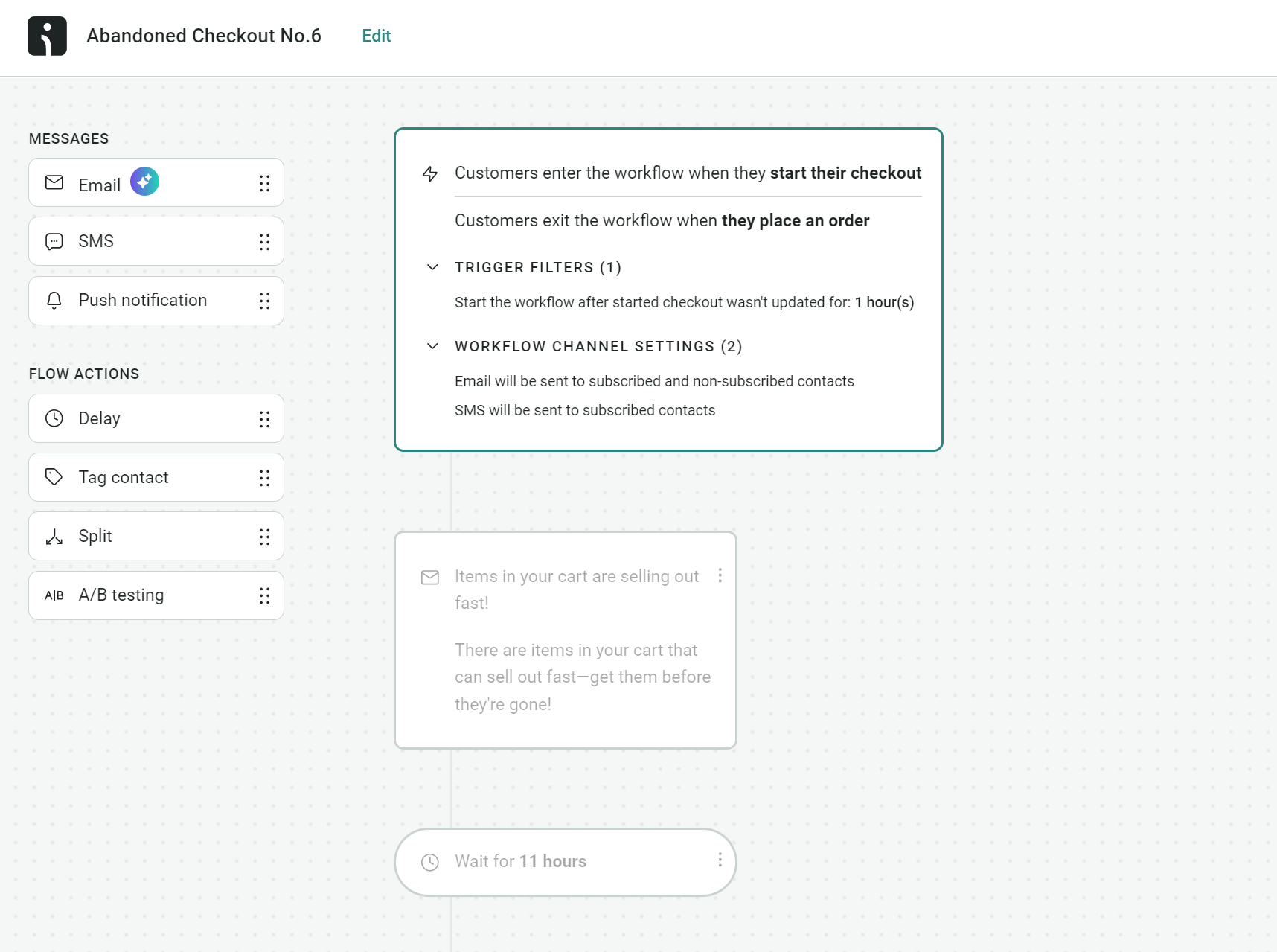
See those message items for email, SMS, and push notifications? You can drag those into your flow and change their settings in seconds.
Plus, Omnisend lets you create one-time campaigns for each channel:
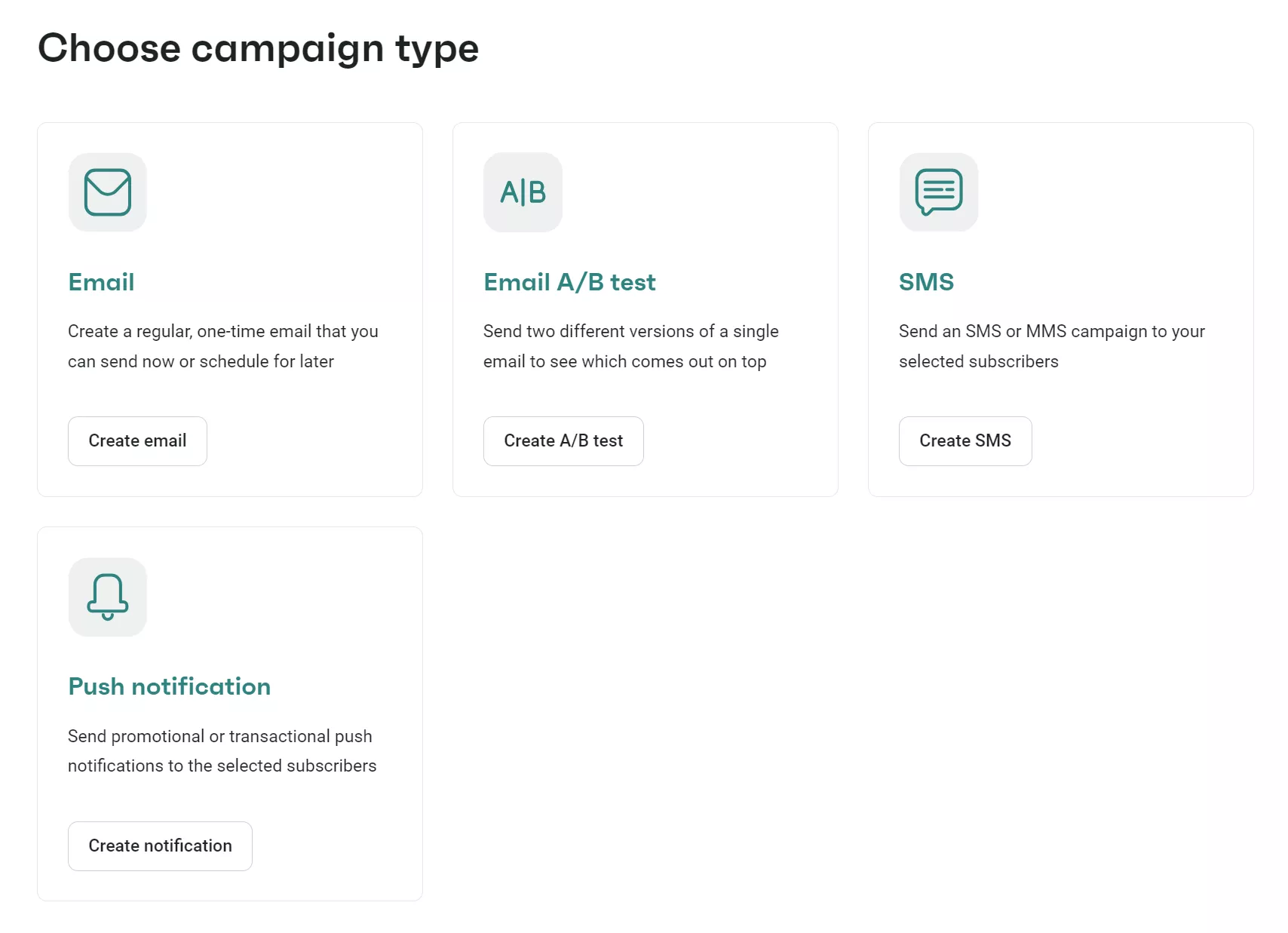
The best part is that everything reports together. You can see which channel drives conversions for different segments. Track if SMS recovers carts that email couldn’t reach. Monitor push notification performance alongside email metrics.
If you choose the Pro plan at $59 monthly, you’ll receive $59 in bonus SMS credits each month. Push notifications are unlimited on all paid plans.
Naked & Famous Denim switched from Mailchimp to Omnisend for native Shopify integration and true omnichannel capabilities. Its automated flows now generate 19.75% of all email revenue while accounting for less than 2% of sends. The abandoned cart series alone drives $6.33 per email — a 4,400% lift over standalone campaigns.
Read the case study.
Mailchimp’s add-on model
Mailchimp bundles SMS with email plans at higher price points. For 500 contacts, you’ll pay $33/month for Essentials + SMS (versus $13 for email only), or $40/month for Standard + SMS (versus $20). Premium + SMS starts at $317.50/month.
Even with these bundled plans, SMS credits cost extra after initial allotments. SMS campaigns run separately from email workflows — you can’t mix channels in one sequence. Mailchimp push notifications remain unavailable regardless of the plan.
Reporting stays siloed, too. Email metrics live in one place, SMS in another. Comparing channel performance requires manual work across multiple reports.
Mailchimp vs. Omnisend round eight winner: Omnisend
9. Omnisend vs. Mailchimp: Customer support options
Documentation and video tutorials help, but let’s be honest — you’ll eventually need human support. Maybe you’re troubleshooting why segments aren’t receiving emails, or you need help setting up complex automation logic.
The question isn’t if you’ll need support, but whether you’ll get it when you do.
Omnisend’s support
You get 24/7 live chat and email support on every Omnisend plan, including free. Whether you’re paying nothing or thousands monthly, you receive the same support access. Response times average under three minutes for chat, with agents available around the clock in every time zone.
If you’re spending $400 or more monthly, you’ll also receive a dedicated Account Expert. Account Experts provide regular business reviews, help optimize campaigns, and offer strategic guidance beyond technical troubleshooting.
The support team handles everything from basic setup questions to complex automation debugging. With over 4,500 five-star reviews specifically praising support quality, customers consistently highlight the expertise and patience of support agents.
Mailchimp’s support
Mailchimp restricts support based on what you pay. If you’re on the free plan, you get email support for your first 30 days only — after that, you’re limited to help articles and the AI chatbot.
Paid plans have 24/7 chat and email support. If you’re on Premium ($350/month minimum), you add phone support to the mix. Account Experts require custom enterprise plans spending at least $299 monthly.
In essence, Mailchimp’s tiers mean your support quality depends entirely on your budget. If you’re on Essentials, you won’t get phone support during critical moments. Free plan? You lose human support after your trial period ends.
Why this matters
When your Black Friday campaign needs last-minute adjustments or automation logic requires debugging during a flash sale, immediate expert help saves revenue.
If you choose Omnisend, you get help regardless of budget. If you pick Mailchimp on a lower tier, you’re on your own when it counts.
Mailchimp vs. Omnisend round nine winner: Omnisend
Real experiences: Omnisend vs. Mailchimp, according to users
Mailchimp scores 4.3/5 on G2 but drops to 2.9/5 on Trustpilot — a massive gap. G2 reviewers tend to be enterprise customers with Premium plans and dedicated support. Trustpilot? That’s where everyday businesses vent their frustrations.
Omnisend keeps it consistent — 4.6/5 on G2, 4.4/5 on Trustpilot. When power users and small businesses give you similar high ratings, you’re delivering value across the board.
Here’s a table comparing their ratings:
| Tool | G2 rating | Trustpilot rating | Capterra rating | Reviewers appreciate |
|---|---|---|---|---|
| Omnisend | 4.6/5 | 4.4/5 | 4.7/5 | Intuitiveness, advanced email builder, ecommerce flows |
| Mailchimp | 4.3/5 | 2.8/5 | 4.5/5 | Campaigns, integrations, small business focus |
Customers appreciate Omnisend’s fast setup and intuitive features, including its pre-built automations, segments, and AI features in all plans. It’s popular with Shopify, WooCommerce, and Wix stores, covering their whole customer journey.
In contrast, Mailchimp customers appreciate its integrations (300+), campaign builder, and how it strips back features to focus on the basics in its free and Essentials plans. However, its email and flow-building tools have complaints about clunkiness.
Reviews
The most reliable reviews come from people who need support, because when things go wrong, it leaves the tool’s team nowhere to hide — either they provide a resolution promptly, or they frustrate their customers.
This Trustpilot reviewer appreciates Omnisend’s support team and says the tool offers a good customer experience:
Had a bit of trouble figuring out how…
“Had a bit of trouble figuring out how to set up abandoned cart and checkout workflows to fit my needs, but customer support team was helpful, they even made some changes for me. Overall good experience, though I would love to see more email templates (I’ve already passed that feedback along).”
Another reviewer, this time on G2, says Omnisend has incredibly fast support and that their requests are always dealt with:
Faster, cheaper, better
“I like that it works much faster than Klaviyo (page loading speed basically), I like that updates ship faster, I like the speed of technical support, I like support that agencies receive. Partnership manager (Ruta) is amazing. I like that I can affect future updates and my voice actually matters. I like that Omnisend makes me feel valuable as a partner, so I actually want to bring more clients here. I like partnership program payouts.”
Moving on to Mailchimp, it has a mix of reviews for support. This G2 user appreciates the helpful support team and the tool’s ease of use:
A Powerful Yet Easy-to-Navigate Marketing Automation Platform for Your Business
“I think the best thing about the product is how easy it is to use. It’s simple to navigate, with less clutter, a great collection of pre-built templates, and smooth integration. The ability to schedule newsletters is a huge plus, and the support team is really helpful too.”
However, this Trustpilot reviewer has much worse things to say:
Full of bugs and poor support
“Support is terrible. Was asked questions like ‘why do you think it’s not working’. Finally had a call with onboarding team who didn’t know why my simple automation wouldn’t work and neither did 3 people from ‘expert support’. Outsourced customer service, overpriced vs competitors and a faulty product sometimes.”
Omnisend vs. Mailchimp: Feature comparison
Explore how Omnisend and Mailchimp stack up in this detailed feature-by-feature comparison — complete with a breakdown of each tool’s strengths and clear winners for every category:
| Feature | Omnisend | Mailchimp | Winner |
|---|---|---|---|
| Target audience | Built for ecommerce with specialized tools for online stores | General-purpose platform for various business types | Omnisend — Purpose-built for ecommerce needs |
| Free plan | 250 contacts, 500 emails/month with full automation and access to all standard features | 500 contacts, 1,000 emails/month, but NO automation or advanced features | Omnisend — All standard features available |
| Pricing (starts from) | $16/month — 500 contacts, 6,000 emails, all standard features | $13/month — 500 contacts, 10x contact send limit (5,000 emails), feature restrictions | Omnisend — Better value with full features |
| Email templates | 250+ templates available to all customers (free and paid) | Limited templates, fully designed ones restricted to paid plans | Omnisend — More options for everyone |
| Marketing automation | 27 pre-built ecommerce flows, unlimited complexity, multi-channel in one workflow | Basic automation on paid plans only, channels run separately | Omnisend — Superior automation capabilities |
| Abandoned cart recovery | Built-in with advanced features, multi-channel sequences | Similar capabilities, but only available in paid plans | Omnisend — More sophisticated recovery tools |
| Product recommendations | Dynamic, personalized recommendations based on browsing/purchase history | Limited product features, requires manual setup | Omnisend — AI-powered personalization |
| SMS marketing | Bonus credits equal to the price of your Pro plan ($59 = $59 SMS credits) | Requires a more expensive email + SMS plan, starting at $33/month | Omnisend — Better SMS integration and value |
| Push notifications | Unlimited on all paid plans | Not available | Omnisend — Additional channel advantage |
| Segmentation | Pre-built ecommerce segments (VIP, likely to buy, etc.) | Basic segmentation, advanced features on higher tiers only | Omnisend — Ecommerce-focused targeting |
| A/B testing | Available on all plans including free | Restricted to paid plans only | Omnisend — Testing for everyone |
| Reporting and analytics | Product-level revenue tracking, unlimited historical data | Standard metrics, limited to one-year history on most plans | Omnisend — Deeper ecommerce insights |
| Deliverability tools | Dedicated dashboard, risk scoring, proactive monitoring | Basic tools, no dedicated dashboard | Omnisend — Better inbox placement tools |
| AI features | Available to all — subject lines, content, segmentation | Restricted to Standard and Premium plans only | Omnisend — AI without restrictions |
| Ecommerce integrations | 160+ deep integrations with Shopify, WooCommerce, review apps, loyalty programs | 300+ integrations, but less ecommerce depth | Mailchimp — More integrations overall |
| Customer support | 24/7 live chat and email for ALL plans (including free) | Free plan loses support after 30 days, chat/email on paid only | Omnisend — Universal support access |
| User ratings | 4.6/5 (G2), 4.4/5 (Trustpilot), 4.7/5 (Capterra) | 4.3/5 (G2), 2.8/5 (Trustpilot), 4.5/5 (Capterra) | Omnisend — Consistently higher ratings |
The final verdict: Should you choose Omnisend or Mailchimp?
If you have an online store on Shopify, BigCommerce, or WooCommerce, then Omnisend wins hands down with abandoned cart flows, browse abandonment triggers, and product recommendations as standard features.
You’ll pay less while getting more — unlimited emails, SMS credits equal to the price of your monthly Pro plans, and workflows mixing all channels (email, SMS, push).
The 24/7 support makes a real difference. Everyone gets expert help, not just paid subscribers. When you’re troubleshooting cart recovery logic or optimizing for Black Friday, immediate assistance saves revenue.
Mailchimp works for different business types. Bloggers sending monthly updates find the interface familiar. Service businesses managing client newsletters use the templates effectively. Nonprofits appreciate the donor management integrations and general marketing tools.
But growth reveals the gaps. Free plans exclude automation entirely. SMS costs extra on top, and support disappears after 30 days unless you have a paid plan.
Bottom line
Ecommerce needs purpose-built tools, which means Omnisend. General businesses might start with Mailchimp, but expect to hit walls fast.
Remember that switching platforms later means rebuilding everything from scratch. Lists, automations, templates, and integrations — all require some manual migration. Save yourself that headache by choosing right the first time.
Quick sign up | No credit card required
FAQs: Omnisend vs. Mailchimp
No automation in the free plans makes it unsuitable for ecommerce. SMS costs extra despite customers expecting text communications. The free plan loses all human support after 30 days, leaving you stranded when issues arise.
Klaviyo dominates enterprise ecommerce with automation and analytics that most stores don’t need. Omnisend captures the mid-market by matching those features affordably. Constant Contact still battles for basic newsletter customers.
Your business model determines the answer. Online stores thrive with Omnisend’s commerce tools. Content creators love ConvertKit’s simplicity. B2B operations suit HubSpot’s CRM integration. Each serves its niche better than Mailchimp’s generalist approach.
Service businesses and B2B companies won’t find much value here — Omnisend builds everything around product sales. The learning curve steepens once you explore advanced automation features beyond basic flows.
The drag-and-drop editor handles newsletters beautifully with responsive templates and easy scheduling. However, paying for commerce features you won’t use seems wasteful if newsletters are your only goal.
This article was researched and written by our experts following a precise process.
See the processTABLE OF CONTENTS
TABLE OF CONTENTS


No fluff, no spam, no corporate filler. Just a friendly letter, twice a month.
Join our free online sessions to learn more about email marketing & sms and get your questions answered live.
Explore webinars
 OFFER
OFFER








